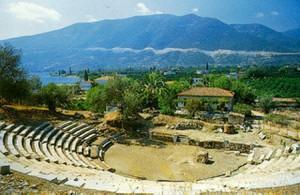Old Epidavros History
The men of Argos, again, and those who held the walls of Tiryns, with Hermione, and Asine upon the gulf; Troezene, Eionae, and the vineyard lands of Epidaurus; the Achaean youths, moreover, who came from Aegina and Mases; these were led by Diomed of the loud battle-cry, and Sthenelus son of famed Capaneus. With them in command was Euryalus, son of king Mecisteus, son of Talaus; but Diomed was chief over them all. With these there came eighty ships. (Homer's Iliad, traslated by Samuel Butler)
 The origins of Epidavros (modern spelling for Epidaurus) are lost in the mists of time. Its sheltered location and natural surroundings, the beauty of the landscape and fertility of the soil attracted not only Man but Gods! It was here that Asklepios’ most splendid sanctuary was situated. Here, yet another important nucleus of ancient Greek civilization was created. The origins of Epidavros (modern spelling for Epidaurus) are lost in the mists of time. Its sheltered location and natural surroundings, the beauty of the landscape and fertility of the soil attracted not only Man but Gods! It was here that Asklepios’ most splendid sanctuary was situated. Here, yet another important nucleus of ancient Greek civilization was created.
Its first inhabitants were the Carians. Later there came the Dorians. The city took part in the Trojan War (see introduction), it fought against the Persians in Plataeae and Salamis, and put itself on the side of the Spartans in the Peloponnesian War. Good sailors and merchants, the people of Epidavros founded colonies and raised their town to a high level. Their civilization came to light during excavations on the peninsula that bisects the bay of Epidavros, the “Island,” as the locals call it today. Remains of the acropolis with Roman walls, ruins of a palace and houses, columns from a Doric temple and, nearby, Mycenaean tombs, while, under the sea, not very deep, lies a section of the ancient city.
Its jewel, however, is to be found on the west side of the peninsula: the ancient theater (Photo). The “little one,” as it has been dubbed, to distinguish it from the “big” one in the Sanctuary of Asklepios. Built in the 4th century B.C., it was dedicated to Dionysus, but for centuries remained buried under six meters (18 feet) of earth. In 1971, archaeologists began their digs. Apart from a few rows of seats, the cavea is made of limestone with poros staircases. And today, elegant with its 6000 stone seats, it not only reaffirms the achievements of ancient civilization, but it also plays host to marvelous late afternoon or evening concerts and, as from 2005, to magical theatrical performances. It has been said that it is worth coming all the way from home to Greece and Old Epidavros, if for nothing else, just for the experience of attending one of these performances, where Self, Art and Nature reach a unique union, something made possible by the serene evenings, the lush surroundings and the small proportions of the theater.
|
|



